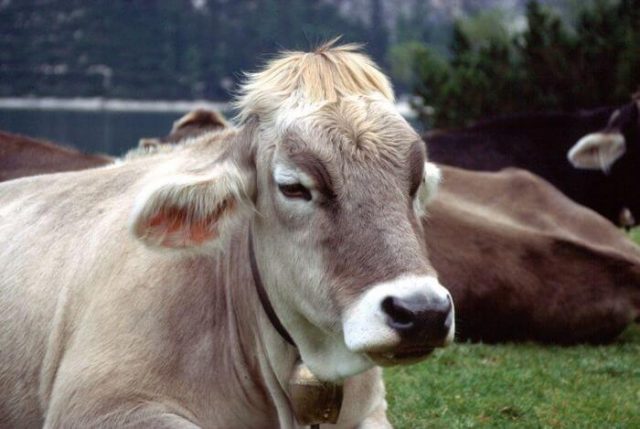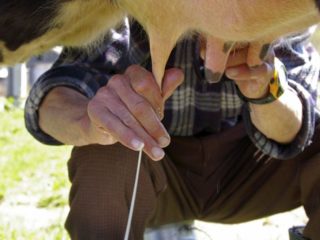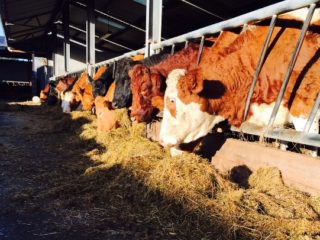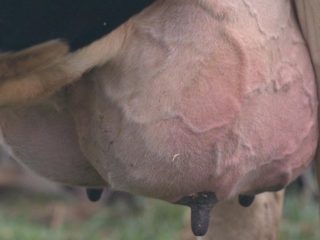Content
A large belly in a calf is a fairly common occurrence on a farm. Young cattle are especially susceptible to various infections that can be transmitted to them primarily with feed, as well as through interaction with other members of the herd. If a calf has a swollen belly, it is necessary to provide it with specialized assistance as soon as possible, otherwise the animal may die.
Possible Causes of Bloating in a Calf
Bloating (also tympanic) is a pathological condition in which cattle have a rapid increase in stomach volume. This phenomenon is based on the expansion of individual parts of the stomach (scar, abomasum, mesh, book) under the pressure of gases accumulated in them. Ultimately, bloating in calves leads to the fact that their digestive processes are disrupted. When the treatment is started, the animals begin to starve, since the accumulated gas presses on the walls of parts of the stomach, deforming other parts, and thereby interferes with the advancement and assimilation of food.
Possible causes of bloating in young animals include:
- transfer of animals to a new type of feed;
- feeding the cubs with poor-quality food: musty raw hay, fermented food, rot, food covered with frost;
- unbalanced diet (consumption of fresh wet grass in large quantities, the prevalence of highly concentrated feed over other products);
- pathologies of the gastrointestinal tract, which are of intrauterine origin;
- ingestion of a foreign object into the esophagus or stomach;
- the presence of parasites in calves;
- viral and bacterial infections;
- inflammation of the digestive tract.
Diagnosing the problem
In the acute course of the disease, bloating in calves is diagnosed for the following symptoms:
- appetite abruptly disappears;
- the chewing gum stops;
- the general condition worsens, the calves become lethargic and lethargic;
- the activity of the scar gradually stops;
- breathing becomes shallow and difficult, young animals develop shortness of breath;
- the animal often coughs;
- frothy discharge forms in the oral cavity;
- calves completely refuse food;
- pulse quickens;
- apathetic state is replaced by short periods of anxiety;
- there is cyanosis of the mucous membranes;
- the hungry fossa rises;
- body temperature may drop;
- the abdomen noticeably increases in volume, with a clear bias to the left.
The calf, whose belly is swollen, stands with its legs wide apart, hunches strongly and now and then turns on its sides. Despite the general apathetic state, the animal can react sharply to external stimuli, including humans. It often hums and pushes forward with the head, however, the muscles in the chest are difficult to work.
The chronic form of the disease is in many ways similar to the acute one, however, the symptoms are not so pronounced. With chronic bloating, the stomachs are disrupted for 1–2 weeks, or even several months. Some of these symptoms are noted only after eating. At the same time, calves rapidly lose weight, grow poorly and clearly lag behind in development.
Treatment methods
If the calf has bloating, never self-medicate. Only a specialist can provide quality medical care.
Therapy for bloating is a comprehensive approach. Treatment focuses on:
- suspension of the fermentation process in the stomach;
- restoration of normal peristalsis in the gastrointestinal tract;
- removal of gases accumulated in the stomach;
- normalization of general digestive processes.
The algorithm for treating bloating in a calf is as follows:
- The animal is placed so that the front of its body is on a slight elevation. This position facilitates the escape of gases through the oral cavity.
- Cold water is poured over the left side of the calf. Immediately after this, it is necessary to perform a circular massage of medium intensity on the left side of the animal. A piece of dry herb is used during the procedure.
- In order for the animal to not be able to close its mouth, the mouths are put on it.
- When the mouth is fixed, you can start trying to induce an eructation. To do this, manually stick out the calf's tongue rhythmically. Alternatively, you can soak the rope in a strong-smelling solution and bring it up to the animal's face. If there is no reaction, the sky of the sick cub is irritated with the help of a rope.
- If attempts to induce belching have not brought the desired result, proceed to the introduction of the probe into the stomach of the calf. To do this, his face is fixed and a probe is inserted through the mouth. If an obstacle is encountered in the path of the probe, it is pulled back a little, after which it continues to move. Properly performed probing provokes the release of gases from the stomach. To avoid clogging the probe, it is sometimes cleaned.
- After the stomach of a sick animal is cleared at least half, it is necessary to pour into the probe 1 liter of a mixture of water and vodka, taken in a 1: 1 ratio. If desired, such a solution can be replaced with a solution of table vinegar. For this, 1 tbsp. l. substances are diluted in 1 liter of water and 1 tsp is added to it. ammonia (can be replaced with soap).
- Based on the weight of the animal, the veterinarian should prescribe Ichthyol (15 g) or Lysol (10 ml) diluted in 1-2 liters of water to the calves.
If even gastric sounding does not help, it is necessary to puncture the scar with a trocar in the area of the hungry fossa. When the gases come out, the trocar is not removed for some time. After removing the tube, the wound must be thoroughly rinsed with a disinfectant solution. The treatment of the hole continues until it is completely healed in order to prevent infection.
The prescription of ruminator drugs, probiotics and enzymes helps to normalize the digestive processes after bloating. It is also necessary to carefully select the diet for the calves in the first days after recovery. Food should not be too heavy.
For more information on treating bloating in cattle, see the video below:
Prophylaxis
Prevention of bloating in calves comes down to the following measures and precautions:
- Calf diets need to be carefully considered. You can not feed animals juicy feed in large quantities. In addition, easily fermenting foods should be avoided.
- The quality of the food is just as important as the type. Under no circumstances should you feed your calves with wet, moldy hay and rotten vegetables.
- Damp fresh grass is especially dangerous for calves, so they should not be taken out to graze immediately after rain.
- New feeds are introduced into the diet of calves gradually so as not to stress the animal. The portions should be small. At the first change in behavior, the new food is discontinued. In this case, it is necessary to find an alternative.
- If the young are artificially fed, cheap substitutes for powdered cow's milk cannot be used to feed the animal.
- Before releasing calves to graze in an area with abundant grass, it is recommended to first drive the animals away to an area with sparse vegetation.
- In the spring, green fodder should not be introduced into the diet of calves in large quantities at once. After winter, animals should gradually get used to the new type of food.
Following these simple guidelines can help prevent bloating in calves and adult animals.
Conclusion
A large belly in a calf is a fairly common phenomenon, often found in animals whose diet is not compiled correctly. In addition, feeding with poor quality food is among the most likely causes of bloating. At the first signs of bloating in calves, it is necessary to provide the sick animal with qualified medical care, it is impossible to self-medicate.









